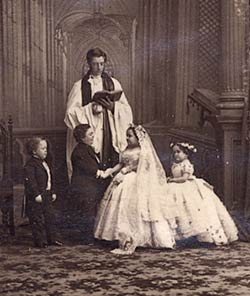General Tom Thumb Gets Married

It had to be an exceptional wedding to earn an entire column of space in the Post. But the ceremony that took place at New York’s Grace Church 150 years ago deserved the coverage.
The groom was Charles Sherwood Stratton, known to the U.S. as General Tom Thumb. His bride was colleague Lavinia Warren. Both were less than 3 feet tall.
The event had been developed and promoted by the great showman P. T. Barnum. He had invited the city’s rich and powerful to witness the marriage of the two most popular members of Barnum’s American Museum. The church was overflowing. Outside, the crowd was so large, the bride and groom’s carriage had trouble drawing up to the doors.
But while Barnum had generated the publicity that drew the crowds that filled Broadway, the wedding was Stratton’s idea. He had met Warren when she came to work as Barnum’s newest attraction and had fallen in love with her. Knowing that another member of the museum, Commodore Nutt (3 feet tall), was also pursuing her, Stratton quickly proposed so that Warren could accompany him on the museum’s next European tour.
After the ceremony, the couple traveled to Washington D.C., where the 2-foot-10-inch Stratton had the opportunity to shake hands with 6-foot-4-inch President Lincoln.
Stratton was 25 years old at the time and had been working with Barnum for 18 years. He was just 4 years old when Barnum had met him and hired him from his parents for $3 a week with a $50 signing bonus.
He instructed the child to mimic the manners of a Victorian gentleman. He also taught him comic routines, which he would perform in costume at Barnum’s American Museum.
The museum was a combination of a zoo, theater, wax works, art gallery, and rifle range. It also exhibited curious celebrities like the elderly black woman said to be George Washington’s nanny, Siamese Twins Chang and Eng, along with several giants, albinos, three morbidly obese brothers, and what was claimed to be the embalmed remains of a mermaid. This irresistible combination drew 15,000 visitors to the museum every day.

When Barnum introduced Stratton as Gen. Tom Thumb to New York audiences, he boosted the child’s age to 11 years to make the child’s shortness even more remarkable. And, knowing that Americans had a “disgraceful preference for foreigners,” he told the public Stratton was an Englishman. He was a huge success.
But after the novelty wore off and Barnum saw ticket sales dip slightly, he packed up the group to tour America and England. Stratton joined the group and was a star from his first performance, even appearing before the royal family several times.
To modern ears, Stratton and Barnum’s story may sound like a classic tale of exploitation—an obscure, disadvantaged child put on display in a freak show. But this working relationship was different. What began as a business arrangement between 4-year-old Stratton and 32-year-old Barnum became a friendship. Barnum took care of his star and paid him well. By the time he retired, Stratton was wealthy enough to own a fashionable house in Manhattan, a yacht, and a custom-built cottage on a Connecticut island.
When Barnum went bankrupt from bad investments, Stratton stepped in with financial help. He also suggested they both return to Europe for another tour, which proved so profitable that Barnum was able to pay off his creditors and restart his business. Eventually, the two men became business partners.
Stratton and Warren lived together as husband and wife for 20 years. By the time he died at the age of 45, he had grown to 3 feet 4 inches tall. The cause of his lack of growth is unclear, though one researcher has pointed out that Stratton was the product of a marriage between first cousins, in a family with a history of dwarfism.
What is remarkable about Stratton is not his height, but his spirit and talent. Right from the start, he eagerly took to the stage and displayed a talent for acting, mimicry, singing, and dancing.
When performing, he would appear in several costumes and recite monologues as a Scottish highlander, then a scholar, a sailor, and finally, paying tribute to another great, short man, as Napoleon. He would also sing, dance, and perform a comic dialogue with a ‘straight man.’ In addition, he appears to have had the ability to improvise. At the end of his act, he would sometimes invite audience members to call out questions, to which he would give humorous replies.
He showed his quick wit when Barnum took him to dinner with a newspaper editor. When Stratton was placed on the dining room table after the meal, he deliberately kicked over a glass of water. When asked why, he replied he had been afraid of falling into it and drowning.
He performed regularly, usually alone on stage, for decades, at the museum and at theaters across America, Britain, Europe, and Japan—all from the age of 4 years old.
Read the original 1863 column on Stratton’s charming New York wedding here.